VE Day 75th Anniversary
To commerate the 75th Anniversary of VE Day on 8th May 2020 the local history group has devised Village Wartime Walkuing & Cycling Tours.
Walking Tour
Click here for Map
W3. Victoria Wallpaper Works & Munitions Store
Cycling Tour
Click here for Map
C1. Cranage Hospital and Cranage Colony
C5. RAF Cranage & Three Greyhounds
C7. Vickers-Armstrong Wellington Bomber Shadow Factory, Byley
W1. Mothers' Union Hut

The Mothers’ Union Hut, which was also known as St Luke’s Church Hall was originally a wooden hut used during the First World War. It was purchased and had been reerected in Westmorland Terrace by December 1919, for use by the local branch of the Comrade’s Club, a national society set up at the end of the war for “Comrades of the Great War”. There were a number of these societies which eventually merged to form the British Legion. The Mother’s Union officially took over the Hut in January 1926 – it’s 20th anniversary is mentioned in the Parish Newsletter for February 1946. During the Second World War, like a number of other locations, it was used for village gatherings such as Jumble Sales, Film Shows, Beetle Drives, etc. It was demolished when the current St Luke’s Church Hall was built in the Co-op car park.
Click here to return to top of page.
W2. Saltersford School
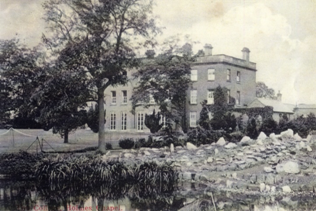
Saltersford Hall was originally built in the 1830s. In 1895 the Cheshire County Council leased the Hall and established the County Council Agricultural & Horticultural College. During the First World War, Land Army girls were trained there. In 1919 the lease was taken over by the Home Office as an annex for the Bradwall Reformatory School. Two years later, in 1921 the Agricultural School was transferred to Reaseheath and Saltersford Hall continued as a reformatory school. It adopted the name Saltersford School in 1925. The school had its own brass band, sports teams, army cadet corps, and also a physical training team that became UK champions in 1929. The Brass Band regularly paraded through the village. One of the Village Fallen from the Second World War, Frank Vasey was assistant carpentry instructor at the School. A Memorial Hall to commemorate the fallen from the First World War, was opened at the school in 1930 by the Home Secretary. Villagers were given the privilege of using the open air swimming pool; and on Saturday evenings the Hall was used as a popular cinema. During the Second World War, the Hall was used for social purposes including ballroom dancing, with the troops who were billeted locally. These included men from the RAF stationed at Cranage, the Americans of Paton’s Army (See Peover Hall below); North and South Staffordshire Regiments, Northumberland Fusiliers, and the Women’s Auxiliary Airforce. Music was provided by bands such as Ivy Benson’s All Girls’ Band, Geraldo and the Glenn Miller Orchestra.
Click here to return to top of page.
W3.Victoria Wallpaper Works & Munitions Store
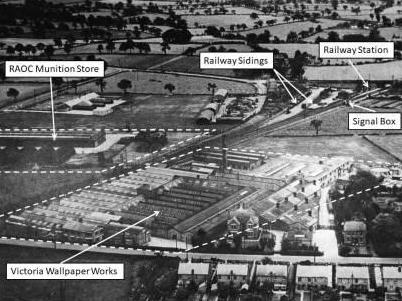
A wallpaper works has been on this site since 1911. At the start of the Second World War, as part of the war effort, wallpaper manufacture ceased, and the factory was employed in packing shells, fabricating Rolls Royce engine parts, and “window” - paper foil which was dropped as strips to confuse enemy radar. The wallpaper works were also the headquarters for the Holmes Chapel troop of the Home Guards. One of their tasks was to protect the Railway Viaduct from sabotage. This was regarded as a far from pleasant duty, made all the more difficult by the narrow space between the track and the parapet, which meant the guard on duty was in some danger when a train passed through. (See also The Vickers Armstrong Wellington Factory, Byley). Across the railway line from the Victoria Works was a RAOC (Royal Army Ordnance Corps) Depot. The land was originally part of Manor Farm, but on 27th September 1939, 24 days after the start of the War, the War Department commandeered the land for a “War Mobilisation Store”, and a small number of soldiers were based there.
Click here to return to top of page.
W4. Sandiford Cottage
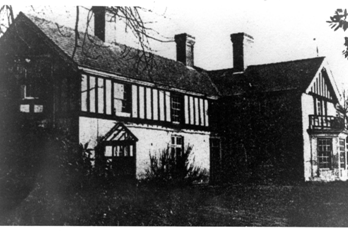
Located where the Fire Station is now, Sandiford Cottage was built in the 19th Century. In the 1920s, it was the home of Ministers in the Church of England until the new Vicarage on London Road was built in 1930. As war approached, it became the HQ for the WVS Women’s Voluntary Service) and TocH. During the Second World War, it was requisitioned by the government and used as a billet for troops, both British and American – some were in tents in the extensive grounds; and later a hostel for German prisoners of war. After the requisition, the WVS moved to a house on Victoria Avenue.
Click here to return to top of page.
W5. Railway Station
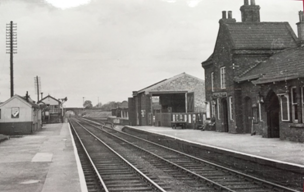
During the Second World War, the station was the site of a serious railway accident at 1:30 am on 14th September 1941. A Crewe to Manchester express train smashed into the rear of the Crewe to York express which was slowly leaving the station after being held by a signal. Both trains were packed with servicemen. The official death toll was put at nine, with thirty-nine injured, though many local people at the time thought these figures had been massaged by the government at a time when the war was going badly for Britain. However, modern scrutiny seems to support the numbers of dead and injured given at the time.
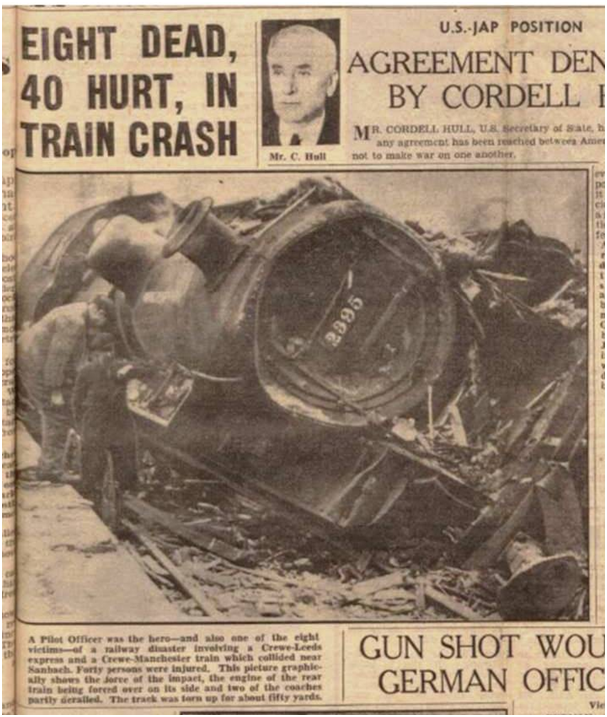
The dead were recorded as: • Pilot Officer William Evans (25), of Newport, Monmouthshire
• Private Claude Lowder (22) of Spring Grove, Fenay Bridge, Huddersfield, Yorkshire
• Sergeant John McCrae (31), RAF, of Park Avenue, Skipton, Yorkshire
• Private John Lennox (24), OCTU, of Jersey Avenue, Stanmore, Middlesex
• First-class Aircraftman Jeffrey Williams (23), of Hull
• George Christie Lowe (39) of Eden Street, Oswestry
• Reginald Gregory (35), Railway Guard, of Llanfair, Pear Tree Lane, Wednesfield
• Stoker J Foster (26) RN, of Grimsby
• Eileen Ann Pritchard (13 months old) of Derby Terrace, Wrexham who was travelling with her mother who was seriously injured.
Click here to return to top of page.
W6. The Good Companions

The Good Companions Hotel opened on Wednesday 15th March 1939, the day after The Bull’s Head closed it’s doors as a public house. Being owned by the same brewery, the license was transferred between the two. The demolition of the Bull’s Head in a road widening scheme was postponed by the war, and it carried on as a boarding house for a number of years. At one time it even housed Italian POWs.
The Good Companions was advertised as a country hotel. It was an imposing building set back from the main road with a large car park to the front. During the Second World War, numerous social events were organised within the building. On VE Day, in the evening, everyone congregated in the car park where there was dancing and drinking, with a band playing on the back of a farm flat-bed trailer.
Click here to return to top of page.
W7. The Victoria Club
The Victoria Social Club was built in 1924 as a social amenity for the workers at the Wallpaper Factory. The club has always boasted a wide variety of sporting facilities, including tennis courts, a bowling green and a cricket square. During the Second World War it was well used for social events such as dances, bridge drives, concerts, plays, etc.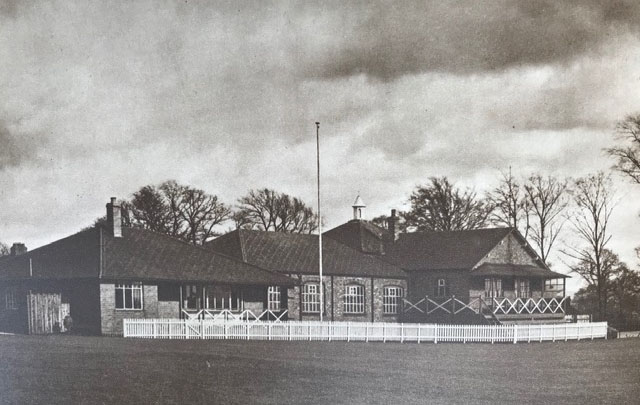
Click here to return to top of page.
W8. The Assembly Rooms
The Assembly Rooms were located on the site of the shops on the south side of Church Walk. Approximately where the road into the Co-op car park crosses the Walk. For many years, this was the only hall in the village, apart from the school rooms available for the village to use for meetings and entertainment. It fell into decline in the 1930s with the opening of Saltersford School Memorial Hall, and also as the Victoria Club became more popular.During the Second World War, the premises under the hall were used by American forces to store equipment. The Hall was also used for social gatherings, but more for normal village activities, such as Brownies, youth club, and films shown by Ivor Williams the grocer.

Click here to return to top of page.
W9. Millingfield Surgery
Saddler’s Close had been the home and village surgery for Doctor Lionel Picton since it was built in 1905/6. However, by the time of the Second World War, the Surgery had moved to Millingfield, opposite The Hollies / Holly Lodge (now Bernard Court, on Chester Road. After the Second World War, he was joined by his son Dr Arthur Picton who was a decorated War hero. Dr Lionel Picton died on 19th November 1948.Click here to return to top of page.
C1. Cranage Hospital and Cranage Colony
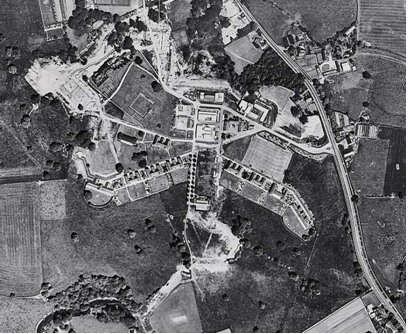
In 1929 Cranage Hall was purchased by the Joint Board for the Mentally Defective, and Cranage Hospital came into being, admitting its first patients in 1932. Cranage Colony refers to the buildings housing the staff who worked at the Hospital. Two of the men who worked at the Hospital were killed during the War: Cecil Batt was Institution Engineer, and Stephen Wormald worked in the Boiler House.
The Crewe Courier reports that on VE Day, a huge bonfire was lit at the Colony in celebration of the end of the War.
Click here to return to top of page.
C2. The Hermitage

The Hermitage estate has been in existence for several centuries. During the Second World War it was requisitioned by the Services. At one point, American Officers were billeted there. Children used to sit along the banks of Hermitage Lane in the hope that troops would come past and hand out sweets.
Click here to return to top of page.
C3. Fontainbleu Cafe & Hostel
The Fontainbleu Cafe catered for travellers in the 1920s and 1930s. After the Second World War it was used by the seed merchant Alty's. It was located on Knutsford Road, Cranage where the Foxfield Court estate is.
During the war the Cafe was used by CWAEC (Cheshire War Agricultural Executive Committee) as a branch-office and hostel. The main office was at Reaseheath. Men were hired out to local farms from the hostel as farm labourers. This Hired Labour included Conscientious Objectors and Prisoners of War – both Italian & German.
Click here to return to top of page.
C4. Toft Hall POW Camp

Prisoners of War were held at a camp in the grounds of Toft Hall near Knutsford. It was built in 1942 and had 20 huts for the guards in their compound and 58 huts in the prisoners compound surrounded by a double perimeter fence with guard towers.
Initially, Italian POWs were housed, but later 95% of the prisoners were German. Toft also served as a transit camp for prisoners of American forces that were being deported to the USA. The prisoners were very much part of the community doing local agricultural work, and attending separate services at Toft Hall church. The daughter of a local farmer recalls her father taking a trailer up to the POW camp to collect men to work on his farm in Allostock. In 1947 1,516 POWs were being held there. The camp closed in 1948.
Click here to return to top of page.
C5. RAF Cranage & Three Greyhounds
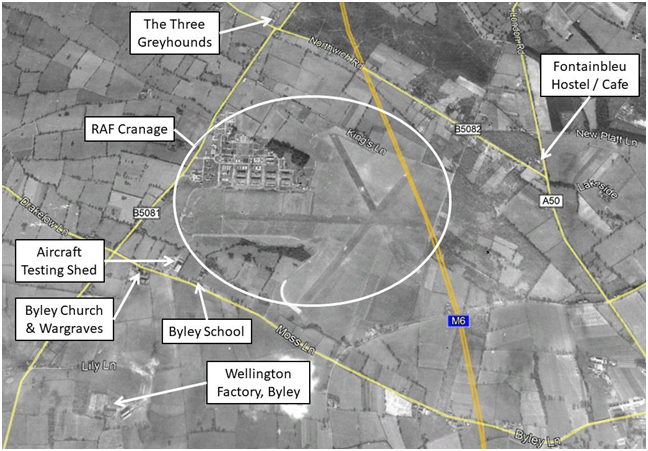
RAF Cranage airfield was located behind Byley School in the area between Moss Lane and Kings Lane. Several farms, including Earnshaw Hall Farm were requisitioned shortly after the start of the war. Work to demolish the farmhouses, clear the ground and build the airfield started in late 1939. The airfield was ready to receive its first units in October 1940.
The first flying unit on site was No 2 School of Air Navigation RAF which was formed on 21st October 1940. In 1942, the unit was renamed the Central Navigation School, and the strength increased to 58 Avro Ansons. As well as the training role, the airfield also housed an operational squadron from December 1940 with the formation of 96 Squadron which was equipped with Hawker Hurricanes. This unit operated in a night air-defence role, mainly in the protection of the industrial and port areas of Liverpool.
Flying ceased at the airfield in March 1947, and the site was used for storage and maintenance until it closed in 1958. Little remains of the buildings, apart from a few air-raid shelters. However the public house which was the local for the personnel at the airfield, The Three Greyhounds, is still thriving. The base hospital is now a private dwelling.
Click here to return to top of page.
C6. Byley Churchyard

At the back of St John’s Church Byley, in the churchyard are 16 War graves from the Second World War, and two from 1946. The men died in accidents at RAF Cranage airfield or close by in Cheshire:
• Sergeant Peter Hill RAF VR (Volunteer Reserve) (20) & Flying Officer Eric Padfield RAF (22) died on 21st March 1941
• Sergeant Ivan Robinson RNZAF (Royal New Zealand Airforce) (20) died on 22nd July 1941
• Flying Officer John Botting RAF VR, Flight Sergeant Brian Bowman RAF (25), Flying Officer George Buxton RAF VR (21), Flight Sergeant Charles Forrest RAF, Warrant Officer Leonard Salter RAF (31), Flying Officer George Seale RAF VR, Corporal Reginald Snashall RAF (22), Flight Sergeant David Williams RAF (21) died on 28th April 1942
• Sergeant James Matheson RCAF (Royal Canadian Air Force) (22) & Sergeant Richard Reay RCAF (20) died on 15th October 1942
• Flight Sergeant William Forbes RAAF (Royal Australian Air Force) (23) & Flight Sergeant Leonard Watson RAAF (24) died on 20th March 1943
• Aircraftman Patrick Clarke RAF VR (19) died on 17th June 1943
• Petty Officer George Reynolds RN (Royal Navy) (24) & Commander (E) Lawrence Sharman RN (37) died on 11th February 1946
Two Germans were also buried in the churchyard:
• Leutnant (Pilot Officer) Johann Glaenzinger (pilot) & Unteroffizier (Corporal) Gerhard Haumgart (wireless operator) died on 3rd May 1941. However, in the 1960s they were re-interred at the German Military Cemetery on Cannock Chase.
Click here to return to top of page.
C7. Vickers-Armstrong Wellington Bomber Shadow Factory, Byley
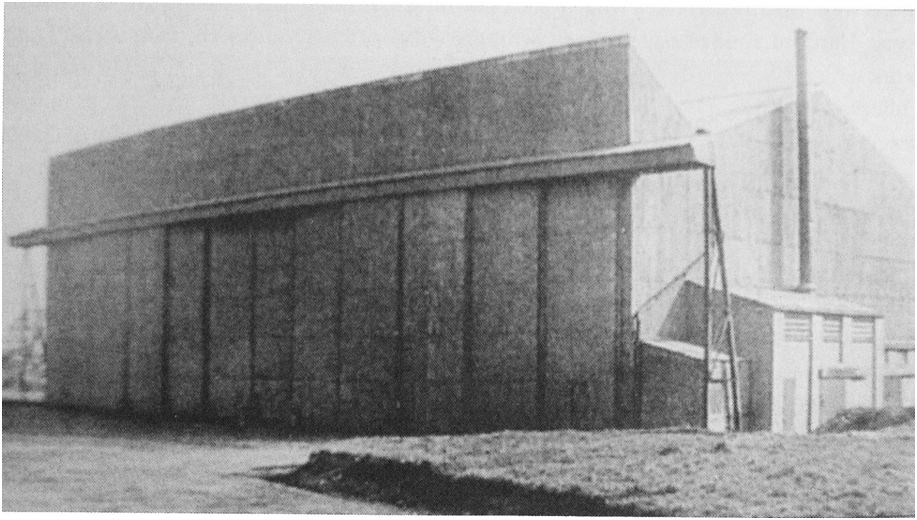
In September 1941, a Wellington Bomber assembly factory came into operation at Byley. It consisted of assembly sheds, which still exist, being used by a haulage company. They are located several hundred yards south west of the airfield to the east of the B5081 and immediately south of Lily Farm. It was linked to the airfield and a substantial Flight Shed (adjacent to Moss Lane and Byley School) by a track. Both the buildings and the winding nature of the track were designed to make the site difficult to spot from the air.
The Byley site was a “shadow factory” to the Vickers Armstrong factory at Hawarden near Chester. The buildings consisted of a linked pair of steel-framed hangars with large opening doors facing the airfield. Lookout towers were built at each end, probably for anti-aircraft and anti-parachute look-outs.
The wing assemblies for Wellington Bombers were delivered from Vickers Armstrong in Chester on low loaders. Because of the narrowness of the road between “The George & Dragon” and “The Bull”, the lorries that came via Middlewich had to go down Back Lane (now called Chester Road), and then turn left on to London Road so that they had a “straight run” at the gap between the two pubs. Unfortunately, that meant that they had to manoeuver past St Luke’s. The first wing that went past necessitated the removal of the iron gates in front of the church!
The delivered wing assemblies were built into complete aeroplanes. Once built, they were towed across the field to the Flight Shed where the engines were test run, everything checked and a test flight made. If all was in order then either RAF or civilian ATA pilots would deliver the planes to their units.
On 29th July 1943, a Byley Wellington crashed at RAF Cranage while being tested killing the pilot, Flight Officer Rouff and the Test Inspector Mr Edward Both. These are the only recorded deaths at the Byley factory.
By the closing down of the production lines in September 1945, a total of 5,548 Wellingtons had been built at Chester and Byley. An accurate break down of the figures is not known, but Byley’s contribution could have been close to 1,850 (i.e one third). A platoon of the Holmes Chapel Home Guard including men working at the factory and local men, guarded the factory site at night.
Click here to return to top of page.
C8. Peover Hall
Peover Hall was requisitioned from the Mainwaring family during the war, and was used by the American General George Patton as his HQ during preparations for the Normandy Landings. The house has changed a good deal since the Second World War, and the 18th century wing which Patton occupied has been demolished. The remaining Tudor portion has been extensively restored. But only the Drawing room was used by the Americans, as an Officer’s Mess.
200 – 300 American troops lived in huts in the park. Nearby is St Laurence’s Church where Patton was a regular worshipper, and the flag he presented to the church still hangs there.
Click here to return to top of page.
C9. Bells of Peover
Between Holmes Chapel and Knutsford in the village of Lower Peover is the pub “The Bells of Peover”. This inn dates from round the 13th century and is noted for its connection to General Patton. He was a regular visitor when he was based at Peover Hall. He and his staff enjoyed the opportunity to relax there. Eisenhower even joined Patton on one occasion for lunch.
Click here to return to top of page.
C10. Bengers Factory
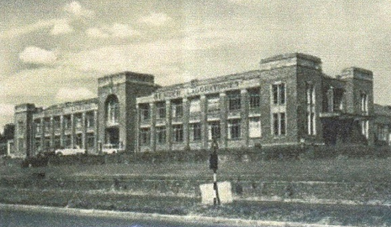
Just past the railway bridge on London Road, to the south of the village, on the left, was The Bengers Factory. The site was originally built for Benger’s Limited in 1938. Bengers food was a speciality food for invalids, nursing mothers, etc. During the Second World War, it continued to make its products, and was in demand to help restore returned released Prisoners of War to better health.
Click here to return to top of page.
